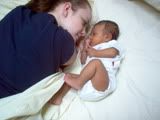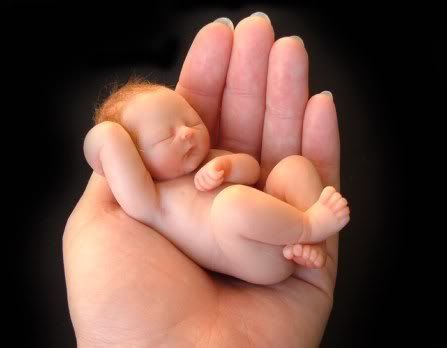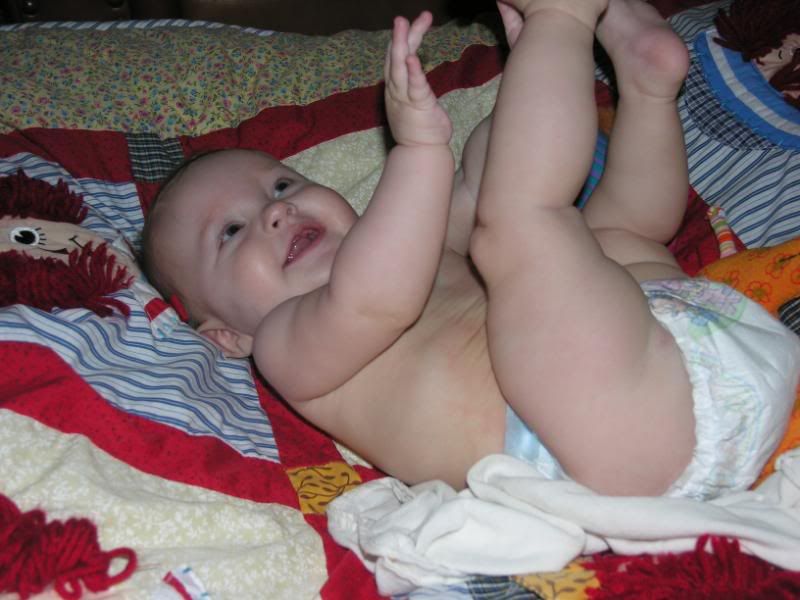Kenyatta:
When I was pregnant, I was scared, confused by all the information out there, and began keeping a little notebook about various things, including all I could on breastfeeding.
I managed to meet a very nice person, who became a "mentor" of sorts, and she not only gave me tremendous support during a scary pregnancy, but a lot of helpful information about various issues concerning breastfeeding, which she knew I really wanted to do.
If you all don't mind, I'd like to post some of the information about nipple confusion which she passed on to me, and which I found extremely informative.
What is Nipple Confusion?
It is a problem that arises when a breastfed baby is given an artificial (rubber or silicon) nipple and must try to learn to nurse both from his mother's breast and the bottle nipple. While seemingly similar, these two feeding methods require COMPLETELY different mouth and tongue motions and swallowing skills.
In breastfeeding the baby needs to take as much of the nipple and areola into his mouth as possible to 'pump' the milk from the milk ducts. In bottlefeeding he uses his lips to grip the tip of an artificial nipple. Some nipples do better imitate a natural breast, but none are quiet the same.
In breastfeeding the baby must place his tongue BENEATH the nipple and uses it to help create the 'vacuum' needed for nursing and to pump and swallow the milk. In bottlefeeding the baby must place his tongue in front of the nipple and uses it to stop the flow of milk while he swallows.
In breastfeeding the baby removes milk from the breast by a combination of sucking and pumping the milk from the milk ducts. When the baby stops sucking & pumping the milk stops flowing. In bottlefeeding the milk flows fairly readily from the nipple once an initial suction is created and then the baby simply controls the flow by placing his tongue over the holes in the nipple.
This is not to say that either feeding method is 'wrong' ... only that they are VERY different and that a baby must learn whichever method he is to use ... and expecitng a tiny baby to learn both methods and to be able to switch back and forth between the two can be extremely frustrating to both baby and mom.
In Dr. Jack Newman's article More & More Breastfeeding Myths he discusses nipple confusion as NOT being a "myth": (text from his articles is in italics)
9. There is no such thing as nipple confusion.
Not true! A baby who is only bottle fed for the first two weeks of life, for example, will usually refuse to take the breast, even if the mother has an abundant supply. A baby who has had only the breast for 3 or 4 months is unlikely to take the bottle. Some babies prefer the right or left breast to the other. Bottle fed babies often prefer one artificial nipple to another. So there is such a thing as preferring one nipple to another. The only question is how quickly it can occur. Given the right set of circumstances, the preference can occur after one or two bottles. The baby having difficulties latching on may never have had an artificial nipple, but the introduction of an artificial nipple rarely improves the situation, and often makes it much worse. Note that many who say there is no such thing as nipple confusion also advise the mother to start a bottle early so that the baby will not refuse it.
In his article Breastfeeding?Starting Out Right he goes on to say ...
3. Artificial nipples should not be given to the baby. There seems to be some controversy about whether "nipple confusion" exists. Babies will take whatever method gives them a rapid flow of fluid and may refuse others that do not. Thus, in the first few days, when the mother is producing only a little milk (as nature intended), and the baby gets a bottle (as nature intended?) from which he gets rapid flow, he will tend to prefer the rapid flow method. You don?t have to be a rocket scientist to figure that one out, though many health professionals, who are supposed to be helping you, don?t seem to be able to manage it. Nipple confusion includes not just the baby refusing the breast, but also the baby not taking the breast as well as he could and thus not getting milk well and /or the mother getting sore nipples. Just because a baby will "take both" does not mean that the bottle is not having a negative effect. Since there are now alternatives available if the baby needs to be supplemented (see handout #5 Using a Lactation Aid, and handout #8 Finger Feeding) why use an artificial nipple?
In his article How to Know a Health Professional is not Supportive of Breastfeeding he goes on to say ...
5. S/he tells you that there is no such thing as nipple confusion and you should start giving bottles early to your baby to make sure that the baby accepts a bottle nipple. Why do you have to start giving bottles early if there is no such thing as nipple confusion? Arguing that there is no evidence for the existence of nipple confusion is putting the cart before the horse. It is the artificial nipple, which no mammal until man had ever used, and even man, not commonly before the end of the nineteenth century, which needs to be shown to be harmless. But the artificial nipple has not been proved harmless to breastfeeding. The health professional who assumes the artificial nipple is harmless is looking at the world as if bottle feeding, not breastfeeding, were the normal physiologic method of infant feeding. By the way, just because not all or perhaps even not most babies who get artificial nipples have trouble with breastfeeding, it does not follow that the early use of these things cannot cause problems for some babies. It is often a combination of factors, one of which could be the using of an artificial nipple, which add up to trouble.
But what if your baby has already been given bottles? Perhaps in the hospital against your best wishes ... or perhaps because of a condition which prevented the baby from nursing for a while? Is all hope lost? Absolutely Not!
Babies CAN learn to breastfeed after being bottlefed, and babies can even learn to do both. Some suggestion are ...
- If at all possible delay introducing the bottle until the baby has WELL established nursing and latch on skills.
- If baby must receive suppliments early on, use a Supplimental Nursing System, feeding cup, medicine dropper or spoon to feed baby.
- Avoid the use of pacifiers which only further enforce the "tongue in front" nursing
- Pump or hand express a bit of milk before attempting to latch baby on so that your milk is READILY available, as it is with a bottle, and baby doesn't become frustrated waiting for let down.
- Attempt to nurse frequently, but be prepared to offer expressed milk or formula if your baby is not able to nurse efficiently.
- Be sure baby is latching on properly - taking the entire nipple and as much areola into his mouth as possible. DO NOT allow baby to suck on just the tip of your nipple ... he will not get milk, and you will end up with sore nipples. If baby is latched on imporperly, use your finger to gently break his suction and try again.
- Seek 'in-person' help from a local lactation consultant or LaLeche League leader if one is available. But be sure to find a support person that you feel comfortable with ... working with someone who makes you tense or upset will only make matters worse.
- And finally ... Be patient with yourself and your baby. It is common to have difficulties with nursing ... and it doesn't mean you or your baby are a failure ... it simply means that it will take extra effort and patience to make things work for you.
Nathanx97:
Make SURE in the hospital they know you are breastfeeding AND that they don't give bottles of ANYthing, including pacifiers. They gave my son BOTH fo these, WITHOUT informing me. He had terrible nipple confusion, and would SCREAM every time he tried to latch onto me, out of frustration. Coincidence? I think not! See if your OB, Ped's office, or your HOSPITAL has a free lactation consultant. Sure, you can pay someone, which is fine, but the one who helped us the most was the free one, not the one we paid!




 LisaMc:
LisaMc:
























